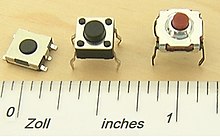Switch
[1][2] The most common type of switch is an electromechanical device consisting of one or more sets of movable electrical contacts connected to external circuits.Switches in high-powered circuits must have special construction to prevent destructive arcing when they are opened.The most familiar form of switch is a manually operated electromechanical device with one or more sets of electrical contacts, which are connected to external circuits.The ideal switch is often used in circuit analysis as it greatly simplifies the system of equations to be solved, but this can lead to a less accurate solution.Theoretical treatment of the effects of non-ideal properties is required in the design of large networks of switches, as for example used in telephone exchanges.The contact material is chosen for its resistance to corrosion, because most metals form insulating oxides that would prevent the switch from working.To prevent the formation of insulating oxides, a minimum wetting current may be specified for a given switch design.When the contacts are separated by an insulating air gap, they are said to be "open", and no current can flow between them at normal voltages.Their bouncing and non-synchronous closing of the switches is known as Hammond Click and compositions exist that use and emphasize this feature.The plasma is of low resistance and is able to sustain power flow, even with the separation distance between the switch contacts steadily increasing.A puffer may be used to blow a sudden high velocity burst of gas across the switch contacts, which rapidly extends the length of the arc to extinguish it quickly.In AC power service, the current periodically passes through zero; this effect makes it harder to sustain an arc on opening.For this reason, power switches intended to interrupt a load current have spring mechanisms to make sure the transition between on and off is as short as possible regardless of the speed at which the user moves the rocker.When a strongly inductive load such as an electric motor is switched off, the current cannot drop instantaneously to zero; a spark will jump across the opening contacts.Providing a sufficient amount of wetting current is a crucial step in designing systems that use delicate switches with small contact pressure as sensor inputs.The moving part that applies the operating force to the contacts is called the actuator, and may be a toggle or dolly, a rocker, a push-button or any type of mechanical linkage (see photo).The interior lamp of a household refrigerator is controlled by a switch that is held open when the door is closed.One form of rotary switch consists of a spindle or "rotor" that has a contact arm or "spoke" which projects from its surface like a cam.The word "toggle" is a reference to a kind of mechanism or joint consisting of two arms, which are almost in line with each other, connected with an elbow-like pivot.In heating or cooling systems a sail switch ensures that air flow is adequate in a duct.This type of switch performs much better than the ball tilt switch, as the liquid metal connection is unaffected by dirt, debris and oxidation, it wets the contacts ensuring a very low resistance bounce-free connection, and movement and vibration do not produce a poor contact.Knife switches consist of a flat metal blade, hinged at one end, with an insulating handle for operation, and a fixed contact.The disadvantages of the knife switch are the slow opening speed and the proximity of the operator to exposed live parts.Sometimes spring-loaded auxiliary blades are fitted which momentarily carry the full current during opening, then quickly part to rapidly extinguish the arc.












Nintendo SwitchSwitch (disambiguation)Cycle buttonmercury switchDIP switchreed switchElectrical installationsNorth American practiceUnited Kingdom practiceRegulation of electrical installationsBS 7671 UK wiring regulationsIEC 60364 IEC international standardCanadian Electrical Code (CE Code)U.S. National Electrical Code (NEC)AC power plugs and socketsCable trayElectrical conduitMineral-insulated copper-clad cableMultiway switchingSteel wire armoured cableRing main unitRing circuitThermoplastic-sheathed cableElectrical busbar systemCircuit breakersDisconnectorResidual-current deviceDistribution boardConsumer unitEarthing systemselectrical engineeringelectrical componentelectrical circuitelectric currentelectrical contactslight switchsensing elementthermostattoggle switchrotary switchpush-buttonreversing switchcircuit breakersensorsrise timefall timecontact resistanceinsulatingelectrical conductivitywetting currentplatednoble metalsknife switchbrakinginsulating air gapelectronicselectrical powerelectriciansBritish EnglishAmerican Englishpushbutton switchOscilloscoperelaysbattery contactsanaloguelogic circuitssurface roughnesspassivated layersHammond organelectronic organsSchmitt triggermercury-wetted contactslow-pass filteredionizegas plasmaelectric arcelectromagnetic interferencearc suppressionbreakdown voltagetipping-point mechanismconvectionmineral oilPower management integrated circuitSolid-state electronicsSolid-state relaylaser pointerflashlightinductiveelectric motorsnubberresistorcapacitorincandescent lampinrush currentoxidationhumiditysystemsactuatorelectromagnetrefrigeratorswitchgearradio controlledDIP switchData General Novaminicomputercomputingcaps lockfloat switchkey switchlimit switchmicroswitchsail switchPressure switchesmercuryliquid metalcopperdisconnect switchesCommutator (electric)Auto polarity (digital multimeter)H-bridgewireless light switchtouch switchvandal resistant switchesElectronic switchDigital electronicsMOSFET